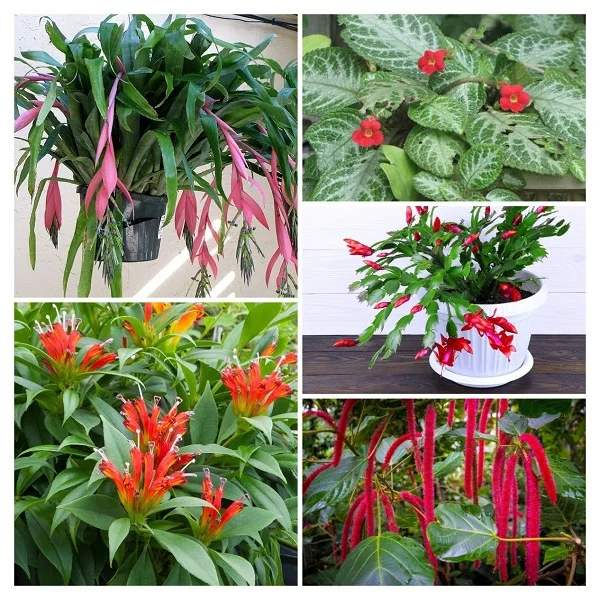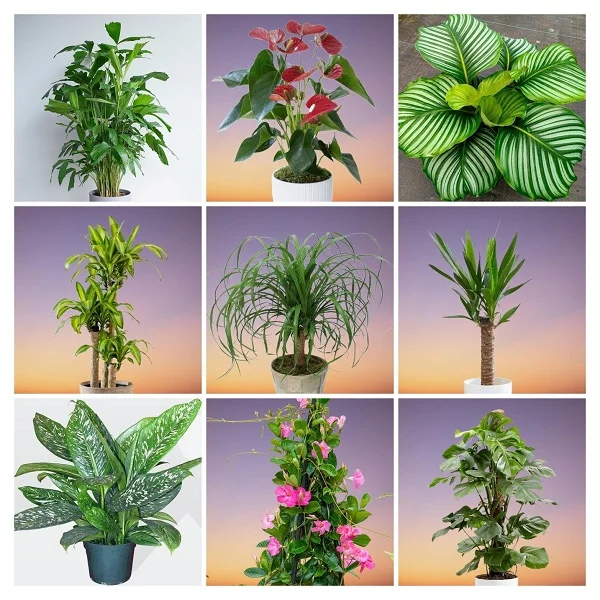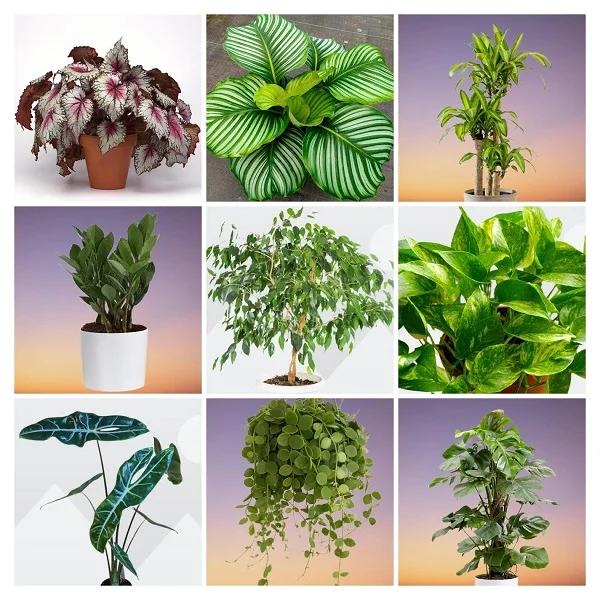Busy Lizzie (Impatiens wallerana) Care Indoors, Propagation, Problems & Solutions
Some links in this post may be affiliate links
Busy Lizzie (Impatiens wallerana) grows best in bright indirect light, warm and humid conditions and consistently moist, rich, well-drained soil coupled with fortnightly feeding in the growing season.
Impatiens wallerana also called Balsam, Sultana or Impatiens Busy Lizzie are popular flowering plants which will bloom almost through out the year when given the proper care.
The leaves are oval and may be all-green, bronze, red, mahogany or red-edged with white. The flowers are very attractive and will brighten up any space with their striking colors.
The genus name 'walleriana' is in honour of a British missionary, Horace Waller (1833–1896).
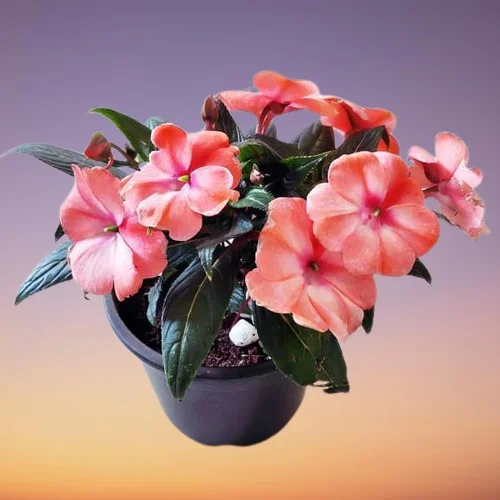
Botanical name: Impatiens wallerana
Family: Balsaminaceae
Synonym: Impatiens sultanii
Common names: Busy Lizzie, Balsam, Sultana, Impatiens Busy Lizzie
Origin
Impatiens wallerana belongs to the family Balsaminaceae and is native to to eastern Africa from Kenya to Mozambique.
Size
Busy Lizzie are compact, houseplants which grow to a height of 2 feet with straggly and fleshy stems. On account of its spectacular flowers, Impatiens like Mandevilla Plants are some of the best plants for the front porch where they will create a great first impression.
Varieties
Impatiens wallerana are a popular group of flowering plants which include the green leaved Impatiens holstii and Impatiens sultani and the red-leaved Impatiens petersiana.
In recent years, breeders and plant hunters have been responsible for hundreds of new varieties of Busy Lizzie plants. An example is the F1 hybrid which is a range of small and compact plants with a mass of blooms which partly or almost entirely cover the leaves.
Is Impatiens wallerana poisonous?
No. As indicated by ASPCA, Impatiens wallerana is non-toxic to humans and pets. Busy Lizzie is safe for humans, cats, dogs and other pets in the home.
How do you care for a Busy Lizzie indoors?
To care for Busy Lizzie indoors, provide bright indirect light, average warmth of 15-240C, humidity of 60-70% and consistently moist, fertile, well-drained soil coupled with fortnightly feeding in spring and summer.
Impatiens wallerana care requires regular pruning to keep it neat and tidy as well as encourage a bushy growth. Repotting is only needed when the plant becomes extremely pot-bound as it blooms best when root-bound. Keep reading for more details on these growing conditions and how to achieve them.
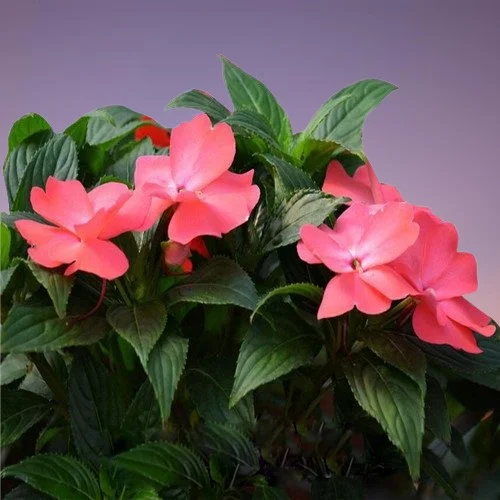
Light Requirements
What is the best place to put Busy Lizzie?
Busy Lizzie Plant thrives in bright light (filtered light). Put it near a bright window away from direct sunlight to prevent scorching of the foliage.
If the light is too little, it will result in no or poor flowering. Therefore, where the natural lighting is not enough, you may instal a grow light to supplement it.
Rotate the pot regularly to make sure that the plant receives light on all sides for uniform growth to prevent lopsided growth.
Watering
How often should I water Impatiens wallerana?
Water your Impatiens wallerana liberally in spring and summer until water drips through the drainage. Allow the top 1-2 inches of soil to dry out between waterings. Maintain the soil consistently moist but not soggy to avoid rotting, yellow and leaf drop.
Cut down on watering in fall and winter to keep the soil slightly moist as growth is minimal at this time. Do not let the soil dry out completely to prevent wilting, yellowing and leaf loss.
Use room temperature water to avoid cold shock as it can lead to stunted growth and leaf fall. Do not use chlorinated water to prevent browning of leaf edges and tips; use rain water or filtered water.
Ensure that the pot has a drainage hole and the soil is well-draining to avoid getting soggy soil which can result in root-rot and death of the plant.
Take care not to wet the flowers and the foliage as it can lead to rotting due to fungal diseases; water from the bottom instead.
Temperature & Humidity
Busy Lizzie prefers an average warmth of 15-240C. Keep it away from sources of drafts like AC units, heat sources, windy doors and others to prevent stunted growth, leaf drop and poor flowering.
Impatiens wallerana flourishes in a humidity of 60-70%; too low humidity may result in brown leaf tips and poor flowering. To increase humidity, set the pot on a wet pebble tray, use a humidifier or group the plants together.
You may also grow the plant in a well-lit bathroom and other the humid areas in the home. Do not mist the leaves as it can promote fungal infections. Maintain good ventilation to minimize fungal diseases.
Fertilizer
What is the best fertilizer for Impatiens wallerana?
Feed your Impatiens wallerana with a phosphorous-rich, water-soluble fertilizer every 2 weeks in spring and summer to encourage blooming. Do not feed in fall and winter as growth is reduced at this time.
Leach out excess salts from the soil every 1-2 months by running a stream of water through the soil until it drains through the drainage hole. Repeat the process several times to get rid of most of these salts.
Potting soil
Busy Lizzie potting soil should be rich in organic matter, loose and free-draining to prevent waterlogging while providing the required nutrients. A blend of 2 parts all purpose potting mix and 1 part perlite is perfect for these plants.
Repotting
Busy Lizzie does not require very frequent repotting as it prefers to be root-bound to enhance flowering. Repot the plant at the beginning of the growing season (spring to early summer), only when it becomes extremely pot-bound.
Use a pot that has a drainage hole and free-draining soil to prevent waterlogging which can lead to root-rot and loss of the plant. Take a look at these pots with drainage holes on Amazon.
Pruning
How to prune Busy Lizzie
Pruning Busy Lizzie involves:
- Removal of dead blooms and leaves to maintain the plant neat and also discourage pests and diseases.
- Pinching off the growing tips regularly to encourage the growth of a bushy, compact plant.
- Cutting back the bare stems at the beginning of the growing season as the plant becomes leggy with time. You may the stems to propagate new plants.
Impatiens wallerana Propagation
Impatiens wallerana propgation is done from seeds or from stem cuttings at the beginning of the growing season (spring to early summer) when the plant is in active growth. The cuttings can be rooted either in water or in soil. We have herebelow outlined 3 propagation methods.
1. Growing Impatiens wallerana from seeds
- Fill a seed tray with a well-draining soil and moisten it slightly.
- Sow the seeds in the moist and cover them lightly with some soil.
- Cover the set up with clear polythene to create warm and humid conditions to hasten germination and establishment.
- Place the set up in a warm, brightly-lit place away from direct sunlight.
- Maintain the soil moist thorough out until the seeds germinate and the plants are well established. The seeds should germinate in 2-3 weeks.
- On germination and development of at least two leaves, gradually remove the plastic cover.
- Allow the new plants to be well established before transplanting into indidual pots after which you can begin routine care.
2. Impatiens wallerana propagation from stem cuttings in water
- Take 4-6 inches stem cuttings from a healthy plant and ensure they have at least 2 leaf nodes.
- Strip off the lower leaves and coat the lower cut end in a rooting hormone to promote rooting.
- Place the cuttings in a jar of plain room temperature water or in a propagation station. Make sure the nodes are submerged, but not the leaves
- Place in a warm, well-lit spot away from direct sunlight. Change the water every 5-7 days to prevent fungal growth.
- When the roots are about 2-4 inches long, transfer the cuttings into individual pots in moist, well-draining soil. Root should appear in 2-4 weeks.
- Position the set up in a warm, well-lit place away from direct sunlight to prevent scorching.
- Maintain the soil moist until there is substantial growth after which you can begin routine care.
3. Impatiens wallerana propagation from stem cuttings in soil
- Take 4-6 inches stem cuttings from a healthy plant and ensure they have at least 2 leaf nodes.
- Strip off the lower leaves and coat the lower cut end in a rooting hormone to promote rooting.
- Fill small pots with free-draining soil and moisten it lightly. Confirm that the pots have good drainage to prevent rotting.
- Insert 1-2 inches of lower cut-end of the cuttings in moist soil.
- Place the set up in a warm, well-lit place away from direct sunlight to prevent scorching.
- Keep the soil moist until new growth emerges and avoid waterlogging as it can lead to rotting of the plants. Rooting will occur in 3-5 weeks.
- Allow the new plants to be well established before transplanting into pots one size larger after which you can begin routine care.
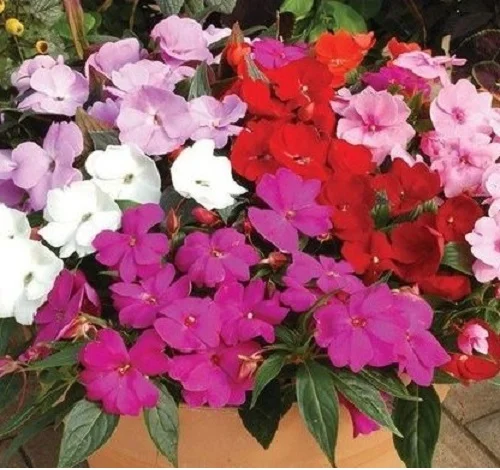
Impatiens wallerana Problems & Remedies
Busy Lizzie problems are yellow leaves, plant dying, wilting leaves, lack of blooms, poor flowering, leaf and flowerbud drop, pests and diseases among others. Keep reading for a more on these problems and their solutions.
Yellow leaves
Why do Busy Lizzie leaves go yellow?
Some of the causes of yellow leaves on Busy Lizzie are too little light, inconsistent watering, soggy soil, nutrient deficiency, temperature stress and aging.
How to fix it
Too little light: Move the plant to a brighter spot or instal a grow light if the natural light is not enough.
Inconsistent watering: Do not water on a schedule. Water only when the top 1-2 inches of soil dry out.
Soggy soil: Use a well-draining soil and a pot with a drainage hole.
Nutrients deficiency: Apply a phosphorous-rich, water-soluble fertilizer every 2 weeks in spring and summer.
Temperature stress: Keep the plant away from drafts emanating from hot surfaces, hot air vents, AC units, windy doors among others.
Aging: This is a natural process; as the plant matures the lower leaves turn yellow and fall off.
Plant dying
Why are my Busy Lizzies dying?
Your Bussy Lizzies are dying due to too little light, incorrect watering, soggy soil, extreme temperatures, dry air or root-rot.
How to fix it
Too little light: Move the plant to a brighter spot or instal a grow light if the natural light is not enough.
Incorrect watering: Do not water on a schedule. Water only when the top 1-2 inches of soil dry out.
Soggy soil: Use a pot with a drainage hole and a well-draining soil.
Extreme temperatures: Keep the plant away from sources of drafts like hot surfaces, hot air vents, AC units, windy doors among others.
Dry air: Use a wet pebble tray or a humidifier to increase humidity.
Root-rot disease which is prevalent in soggy soil and is characterized by yellowing and wilting leaves, rapidly followed by browning and plant collapse.
How to fix it
- Carefully slip the plant out of its pot and inspect the roots.
- Trim the brown-black, mushy roots and treat the healthy roots with a copper-based fungicidal solution as instructed by the manufacturer.
- Disinfect the pot with the fungicidal solution or use a fresh pot to repot the plant in fresh, well-draining soil.
- Do not water the plant immediately; keep it dry for 5-7 days before you can resume watering.
- Use a pot with a drainage hole and well-draining soil to prevent the soil from getting soggy.
- Reduce watering in fall and winter as growth is slowed at this time; keep the soil slightly moist.
Wilting leaves
Why are my Busy Lizzies wilting?
You Busy Lizzies are wilting due to dry air, incorrect watering, soggy soil, being extremely pot-bound or pests infestations.
How to fix it
Dry air: To increase humidity, set the pot on a wet pebble tray, use a humidifier or group the plants together.
Incorrect watering: Water when the top 1-2 inches dry out but do not allow the soil to dry out completely.
Soggy soil: Ensure that the soil is free-draining and that the pot has a drainage hole.
Being extremely pot-bound: Look out for massive amounts of roots growing through the drainage hole and repot the plant into a pot one size larger than the current one.
Pests infestations: Regularly check underneath the leaves for these pests and carry out timely control measures.
Lack of blooms
Lack of blooms on Impatiens wallerana may be caused by too little light, nutrients deficiency, drafts, inconsistent watering, soggy soil or dry air.
How to fix it
Too little light: Move the plant to a brighter spot with bright indirect light or instal a grow light if the natural lighting is not adequate.
Nutrients deficiency: Feed the plant every 2 weeks with a phosphorous-rich, liquid fertilizer in spring and summer.
Drafts: Keep the plant away from sources of drafts like AC units, drafty windows, hot air vents, windy doors and others.
Inconsistent watering: Do not water on a schedule. Water when the top 1-2 inches of soil feel dry but do not allow the soil to dry out completely.
Soggy soil: Use a a pot that has a drainage hole and well-draining soil.
Dry air: Use a wet pebble tray or a humidifier or group the plants together to raise humidity.
Poor flowering
Poor flowering on Impatiens walleranais due to too little light, use of Nitrogen-rich fertilizer, drafts, low humidity or too frequent repotting.
How to fix it
Too little light: Position the plant in a brighter spot or use a grow light if the natural light is not sufficient.
Use of Nitrogen-rich fertilizer: Feed the plant with a phosphorous-rich, water-soluble fertilizer every 2 weeks in spring and summer. Avoid Nitrogenous fertilizer as it promotes vegetative growth at the expense of flowers.
Drafts: Keep the plant away from drafts to maintain an average warmth of 15-240C.
Low humidity: Set the pot on a wet pebble tray, use a humidifier or group the plants together to heighten humidity.
Too frequent repotting: Do not repot unless the plant is extremely root-bound. Repot into a pot that is only one size larger to avoid overpotting.
Leaf and flowerbud drop
Leaf and flowerbud drop on Busy Lizzie is caused by too little light, drafts, dry air, inconsistent watering or pest infestations.
How to fix it
Too little light: Move the plant to a brighter spot or use a grow light if the natural light is not enough.
Drafts: Keep it away from sources of drafts like AC units, drafty windows, hot air vents, windy doors and others.
Dry air: Set the pot on a wet pebble tray, use a humidifier or group the plants together to upscale humidity.
Inconsistent watering: Water when the top 1-2 inches of soil feel dry but do not allow the soil to dry out completely. Do not water on a schedule.
Pests infestations: Regularly check underneath the leaves for these pests and carry out timely control measures.
Pests
The common pests in Impatiens wallerana are spider mites, mealybugs, aphids, whiteflies and thrips all of which cause the leaves to be disfigured or discolored.
How to fix it
- Regularly inspect the plant for pests and take timely control measures.
- Isolate the affected plant to prevent spread to other plants.
- Treat the affected plant with neem oil or insecticidal soap as per the manufacturers' recommendations.
- Regularly damp-wipe the leaves with a soft cloth to discourage the pests.
- Maintain the plant well pruned to decrease the hiding and breeding places for these pests.
Diseases
Busy Lizzie is prone to leaf spot disease which is prevalent in wet and damp conditions. The disease is indicated by brown patches surrounded by a yellow halo (brown, soft leaf spots).
How to fix it
- Remove and burn the affected parts to reduce the risk of spread to the rest of the plants.
- Spray the affected plant with a systemic fungicide and ensure to cover all the parts with the fungicidal solution.
- Keep the plant on the dry side, do not mist it and ensure good air flow.
- Use a pot with a drainage hole and well-draining soil.
You liked it? Share on social media.
Related Content
Amazon Associates Disclosure
Homeplantsguide.com is a participant in the Amazon Services LLC Associates Program, an affiliate advertising program designed to provide a means for sites to earn advertising fees by advertising and linking to amazon.com.



